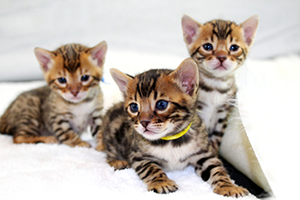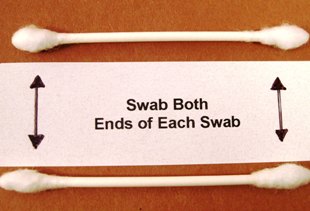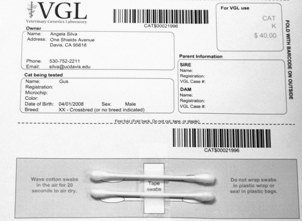Quick Summary
Click here for Price and Turnaround Time
Phenotype: GM2 gangliosidosis is characterized by severe muscle tremors and loss of motor control. The inherited condition in affected kittens is first observed at 6-8 weeks of age beginning with mild tremors and leading to difficulty eating and lack of coordination.
Mode of Inheritance: Autosomal recessive
Alleles: = Normal/Unaffected, GM2 = GM2 gangliosidosis
Breeds appropriate for testing: Burmese, European Burmese
Explanation of Results:
- Cats with N/N genoytpe will not have Burmese GM2 gangliosidosis and cannot transmit this GM2 gangliosidosis variant to their offspring.
- Cats with N/GM2 genotype will not have Burmese GM2 gangliosidosis, but are carriers. They will transmit this GM2 gangliosidosis variant to 50% of their offspring. Matings between two carriers are predicted to produce 25% Burmese GM2 gangliosidosis-affected kittens.
- Cats with GM2/GM2 genotype will have Burmese GM2 gangliosidosis, a progressive neurological condition.
$44 one test per individual animal
Also available as part of the following packages:
$66 this test + one test from list below
$88 this test + two tests from list below
$110 this test + all tests from list below
- Burmese Head Defect
- Burmese Hypokalemia
- Polycystic Kidney Disease (PKD1) (recommended for Burmilla breed)
Cat DNA tests are carried out using cells brushed from your cat's cheeks and gums using household cotton swabs.
The cat DNA submission form with instructions and a place to tape the cotton swabs is sent to you via email after you place an order, and can be printed from your home computer. DNA test kits are no longer mailed.
Instructions
Step-By-Step:
1.
 Purchase regular household cotton swabs for cat DNA collection (the cotton swabs can be purchased at a pharmacy or drug store)
Purchase regular household cotton swabs for cat DNA collection (the cotton swabs can be purchased at a pharmacy or drug store)
2.

Make sure the cat has not had anything to eat or drink for at least 1 hour prior to collecting sample.
When swabbing kittens, isolate each kitten from the mother, littermates and any shared toys for 1 hour prior to swabbing. Kittens should not have nursed or eaten for 1 hour prior to collecting sample.
If collecting samples from more than one cat, make sure to sample one cat at a time and wash your hands before swabbing another cat.
3.
 Use both ends of the two cotton swabs for a total of four swabs.
Use both ends of the two cotton swabs for a total of four swabs.
4.
Place the cotton head of the swab between the cat’s gums and cheek and rub or rotate the swab back and forth for 15 seconds. Repeat with each cotton swab head, for a total of 4 swabs. We recommend swabbing a different area of the gums with each swab head.
5.
Wave the swab in the air for 10-15 seconds to air dry it before attaching it to the submission form.
6.
 After swabbing the cheek and gums, tape the cotton swabs to the bar-coded submission form printed from your MyVGL account.
After swabbing the cheek and gums, tape the cotton swabs to the bar-coded submission form printed from your MyVGL account.
ATTENTION:
- Do not collect saliva/drool – the key to obtaining a good sample is getting cheek cells on the swab.
- Do not rub swab on the cat’s tongue or teeth – this will result in poor quality sample.
- Do not collect a sample from a kitten that has recently nursed – the mother’s genetic material can rub off on the kitten’s mouth and contaminate the sample.
GM2 gangliosidosis is a degenerative, fatal neurological disease characterized by severe muscle tremors and loss of motor control. In Burmese cats, the disease is caused by a mutation that perturbs a neuron's ability to remove metabolic waste products from the cell. The accumulation of waste products results in permanent damage. The inherited condition in affected kittens is first observed at 6-8 weeks of age beginning with mild tremors and leading to difficulty eating and lack of coordination. Symptoms are more evident when the kitten has movement with intent as opposed to tremors at rest. Owners may elect for humane euthanasia as the disease is progressive, often culminating in an inability to walk or eat.
GM2 gangliosidosis is inherited as an autosomal recessive disorder and is caused by a 15 base pair deletion in the HEXB gene (chrA1:1415771029del15) which results in aberrant splicing and the production of a non-functional protein. This mutation has been detected in European Burmese cats in at least five countries, including the United States. At the time of publishing, researchers found the carrier frequency for GM2 gangliosidosis to be 14.5% among tested Burmese cats.
